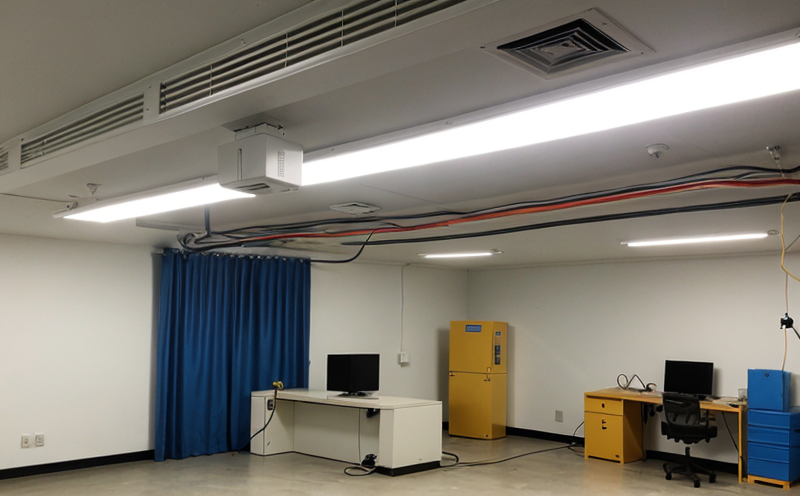EN 12464-1 Lighting of Indoor Work Places
The European Standard EN 12464-1:2000, titled “Lighting of indoor work places - Part 1: General requirements,” sets forth the essential criteria for ensuring proper lighting in indoor workplaces. This standard is crucial for maintaining safety, comfort, and productivity within enclosed spaces such as offices, factories, laboratories, and other environments where human activity occurs.
The primary objective of EN 12464-1 is to establish a harmonized approach across Europe regarding the illumination requirements necessary for performing tasks safely and efficiently. It addresses both general lighting design principles and specific measures aimed at preventing accidents due to poor visibility or glare. Compliance with this standard ensures that employers meet their legal obligations under various national regulations related to occupational health and safety.
One key aspect of EN 12464-1 is its emphasis on ergonomics—ensuring that the lighting conditions support workers' physical well-being while also enhancing visual acuity. The standard recommends using appropriate levels of illuminance depending on task type (e.g., reading, assembly work) and considers factors like color rendering index (CRI), uniformity, contrast ratios between adjacent surfaces, and vertical plane brightness distribution.
Another important consideration under EN 12464-1 pertains to the prevention of glare. Excessive brightness from direct light sources can cause discomfort or even injury if not managed correctly. To mitigate this risk, designers are advised to use indirect lighting techniques whenever possible, incorporate adjustable luminaires, and ensure sufficient spatial separation between fixtures.
For facilities with specialized applications—such as laboratories handling hazardous materials—the standard provides additional guidance tailored specifically towards those sectors. In these cases, special attention must be paid not only to basic illumination requirements but also to ensuring that the lighting does not interfere adversely with sensitive measurements or experimental procedures.
The implementation of EN 12464-1 involves several steps including initial site assessment, selection of appropriate luminaires and fixtures based on task demands and environmental conditions, careful planning of layout configurations, and regular maintenance checks to ensure continued compliance over time. A skilled team of lighting engineers can help organizations achieve full adherence by conducting thorough audits followed by detailed recommendations for improvement where necessary.
In summary, EN 12464-1 plays a vital role in safeguarding employee welfare while promoting efficient operations within various types of indoor workplaces. By adhering to its provisions, businesses demonstrate commitment to creating healthy working environments that enhance overall productivity and satisfaction among staff members.
Applied Standards
| Standard Reference | Description |
|---|---|
| EN 12464-1:2000 | Lighting of indoor work places - Part 1: General requirements. |
| ISO/TR 8997-1 (2015) | Traffic lighting installations - Part 1: General principles and requirements. |
| IEC 61439-2 (2014) | Electrical Installations in Railway Rolling Stock - Part 2: Testing, commissioning and operation. |
| BUILDING CODES AND STANDARDS (VARIES BY COUNTRY) | Local regulations that may supplement or align with EN 12464-1 based on national codes. |
The application of these standards is critical for ensuring consistent quality across different jurisdictions within Europe and beyond. While EN 12464-1 provides a comprehensive framework for general requirements, other international guidelines like ISO/TR 8997-1 or IEC 61439-2 offer additional insights into specific areas such as traffic lighting installations or railway rolling stock.
Additionally, local building codes and standards vary by country but often align closely with internationally recognized practices. For instance, the American National Standards Institute (ANSI) has developed similar standards under Z76.1 series which cover various aspects of indoor and outdoor lighting systems including those related to human factors and performance metrics.
It is essential for organizations operating in multiple regions or countries to stay informed about any updates or amendments made to these standards over time as they could significantly impact compliance efforts and operational practices.
Why Choose This Test
The choice of EN 12464-1 testing is driven by several compelling reasons that address both regulatory requirements and practical considerations:
- Legal Compliance: Ensuring adherence to local laws and regulations regarding workplace safety, health protection, and ergonomics.
- Promotion of Productivity: Proper lighting contributes directly to increased efficiency by improving visibility and reducing errors caused by insufficient illumination levels.
- Enhanced Safety: Adequate light minimizes risks associated with tripping hazards or slips due to inadequate contrast between different surfaces within the workspace.
- Eco-Friendly Solutions: Energy-efficient lighting systems comply with environmental policies while simultaneously lowering operational costs for businesses.
- Aesthetics and Brand Image: Well-lit environments create positive impressions among visitors or clients, contributing positively to品牌形象和声誉。





